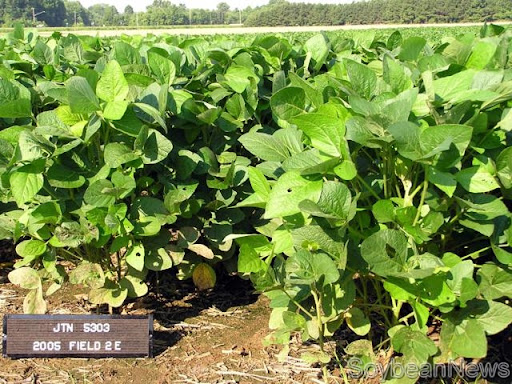Thursday, June 30, 2011
Soybeans futures pare gains ahead of USDA report
 Forexpros - Soybean futures pared gains on Thursday, pulling back from a daily high as markets awaited the release of a key monthly report on U.S. and global grain supplies.
Forexpros - Soybean futures pared gains on Thursday, pulling back from a daily high as markets awaited the release of a key monthly report on U.S. and global grain supplies.
On the Chicago Mercantile Exchange, soybean futures for August delivery traded at USD13.2788 a bushel during European morning trade, gaining 0.25%.
It earlier rose as much as 0.85% to trade at a daily high of USD13.3525 a bushel.
The U.S. National Weather Service said on Tuesday that it expected warmer-than-normal temperatures and below-average rainfall across the Mississippi Delta states during the next ten days, potentially threatening yields and reducing the quality of the harvest.
Approximately 65% of the U.S. soybean crop was rated 'good' to 'excellent' as of last week, down from 68% a week earlier and below the five-year average of 67%, USDA data show earlier in the week.
Global agribusiness financial service provider Rabobank said in a report late Wednesday that lower crop ratings were "providing some support to soybeans. The focus is now on crop conditions and their evolution, rather than planting progress."
Meanwhile, the USDA was to release its closely-watched monthly report on U.S. and global soybean stockpiles later in the day. The agency was also to publish data on quarterly stocks as of June 1 as well as a report on acreage estimates.
The data could show that U.S. soybean inventories dropped to levels below last month's projection, as U.S. farmers delayed planting of the crop due to heavier-than-normal rains in early June.
The U.S. is both the world's largest soybean producing nation and the world's largest exporter of the grain.
Elsewhere, corn for September delivery climbed 0.8% to trade at USD6.8413 a bushel, while wheat for September delivery edged 0.22% higher to trade at USD6.7650 a bushel during European morning trade.
Corn is the biggest U.S. crop, valued at USD66.7 billion in 2010, followed by soybeans at USD38.9 billion, government figures show. Wheat was fourth at USD13 billion, behind hay.
Read more: http://community.nasdaq.com/News/2011-06/soybeans-futures-pare-gains-ahead-of-usda-report.aspx?storyid=83247#ixzz1Qnfe1o00
CBOT Updates: Soybean Meal/Oil ends on mixed trend
 CHICAGO (Commodity Online): Soy product futures end mixed, with soyoil futures rising on support from higher crude oil, with traders taking on long soyoil positions vs short soymeal on spreads.
CHICAGO (Commodity Online): Soy product futures end mixed, with soyoil futures rising on support from higher crude oil, with traders taking on long soyoil positions vs short soymeal on spreads.
Soymeal futures drifted lower, succumbing to pressure from declining cash basis levels amid declining livestock feed demand and increased competition for distillers dried gains in feed rations, analysts said.
CBOT Dec soyoil ended up 0.42c/pound; Dec soymeal finish down $0.60 at $338.10/short ton.
Courtesy: CME Group
Monday, May 30, 2011
Soybean trades down on global cues
 Indian soybean futures traded down side on Saturday owing to the lower closing of the CBOT on Friday. The CBOT closed lower owing to expectations of the recovery in the weather.
Indian soybean futures traded down side on Saturday owing to the lower closing of the CBOT on Friday. The CBOT closed lower owing to expectations of the recovery in the weather.
Across the Indian commodity bourses also the traders went in for profit booking. The concern about the increase in MSP is affecting the domestic market sentiments.
Outlook
NCDEX Soy bean futures are expected to trade down side for the day. The south west monsoon has hit the Kerala coast with the arising the brighter prospects of sowing which might affect the market sentiments.
The considerations of the increase in MSP of oil seeds might come up strongly during the current sowing season to reduce the import dependency of the oil which might keep the prices under pressure. However the good crushing margin might help the prices to recover.
The e-CBOT is currently trading down side on concerns of the weather recovery and the expectations of the better planting during the week. The weather has recovered across the Iowa and nearby regions while it’s forecasted to recover across the north Dakota regions during the week. However the delay in the sowing season might always have concerns about the final yields.
The decline in the international meal prices is also affecting the market sentiments. The USDA supply demand reports might forecast tight supplies during the year prompting the prices to recover.
The USDA census crush data showed a decline in the crushing by 9% (127.9 million bushels v/s 140.3 million) and the soy oil ending stocks with the mills is down by 10% which might help the prices to recover.
Courtesy: Karvy Commtrade Ltd.
Futures market survey: 50 pct bullish about Dalian soybean on Mon.
 BEIJING, May 29, 2011 (Xinhua via COMTEX) -- About 50 percent of futures experts surveyed by the China Finance Corporation, a financial information provider owned by Xinhua News Agency, are bullish about soybean futures traded on the Dalian Commodity Exchange Monday, while 17 percent are bearish and 33 percent expect range-trading of the commodity.
BEIJING, May 29, 2011 (Xinhua via COMTEX) -- About 50 percent of futures experts surveyed by the China Finance Corporation, a financial information provider owned by Xinhua News Agency, are bullish about soybean futures traded on the Dalian Commodity Exchange Monday, while 17 percent are bearish and 33 percent expect range-trading of the commodity.
Futures experts here include futures brokers, research institutions and other market observers.
The futures brokers that are bullish about Dalian soybean include Zhongzhou Futures, Maike Futures, Jinyuan Futures.
The futures brokers that are bearish about Dalian soybean include Zhonghui Futures.
The futures brokers that expect range trading of Dalian soybean include Galaxy Futures and Changjiang Futures.
Dalian soybean for delivery in January of 2012 opened 6 yuan lower at 4,450 yuan/tonne Monday.
Source: http://business-video.tmcnet.com/news/2011/05/29/5541542.htm
Sunday, May 22, 2011
Soybeans, Wheat Decline as Exports From U.S. Trail Government Estimates
 Soybeans and wheat fell in Chicago after government figures showed U.S. exports of the crops trailed official estimates. Corn was little changed.
Soybeans and wheat fell in Chicago after government figures showed U.S. exports of the crops trailed official estimates. Corn was little changed.
Soybean exports from Sept. 1 through May 12 totaled 36.6 million metric tons, the U.S. Department of Agriculture said in a report yesterday. Exporters need to ship 5.55 million tons in 15 weeks, or an average of 369,000 tons a week, through the end of the marketing year on Aug. 31 to meet the official goal. Exporters sold 166,100 tons last week, according to the USDA.
“Fundamentally, the soybean market remains quiet, with Thursday’s weekly export sales and shipment numbers coming in well below what was needed to stay on pace with USDA’s demand projection,” Darin Newsom, senior analyst at Telvent DTN in Omaha, Nebraska, said in a report today.
Soybeans for July delivery fell 4.5 cents, or 0.3 percent, to $13.75 a bushel by 1:15 p.m. London time on the Chicago Board of Trade, reducing the weekly gain to 3.4 percent. The oilseed climbed 46 percent in the past year, partly on rising demand from China, the biggest global importer.
Wheat shippers have sent 31.4 million tons of the grain overseas, USDA data show. Exporters, expected by the government to ship 34.7 million tons by the end of May, would need to ship 3.3 million tons, or 1.1 million tons a week, to reach that goal.
“Total export demand for wheat continues to run behind USDA projections,” Newsom said.
Wheat for July delivery dropped 10 cents, or 1.2 percent, to $8.02 a bushel. That left prices up 10 percent this week, on course for the biggest climb since the week ended Dec. 3. Milling wheat for November delivery traded on NYSE Liffe in Paris fell 1.50 euros, or 0.6 percent, to 242.50 euros ($345.51) a ton.
Corn for July delivery gained 0.75 cent, or 0.1 percent, to $7.49 a bushel in Chicago. Prices are up 9.8 percent this week, on course for the biggest advance since the week ended Oct. 8.
US Soya Complex Surges On Strong Prices of Other Grians
 US Soybean complex prices closed little changed on Friday. July soybeans closed up 3/4 cent at $13.80 1/4. July soybean meal slipped $0.80 to close at $360.60. July soybean oil futures were unchanged at 57.46 cents per pound. New-crop November soybeans closed 1 cent higher at $13.50 1/2. For the week, the soybean market registered gains. July soybeans advanced by 50 3/4 cents, July meal was up $15.20, July soybeans oil rose 132 points, and November beans tacked on 39 3/4 cents.
US Soybean complex prices closed little changed on Friday. July soybeans closed up 3/4 cent at $13.80 1/4. July soybean meal slipped $0.80 to close at $360.60. July soybean oil futures were unchanged at 57.46 cents per pound. New-crop November soybeans closed 1 cent higher at $13.50 1/2. For the week, the soybean market registered gains. July soybeans advanced by 50 3/4 cents, July meal was up $15.20, July soybeans oil rose 132 points, and November beans tacked on 39 3/4 cents.
The corn market did trade higher and that likely helped rescue the beans to some degree. After corn took off to the upside, the soybean market followed suit. Gains of 10 to 15 cents were recorded. But by late in the session, that bullishness wore off and prices closed little change during the week.
CBOT Updates: Soybean ends on mixed trend
 MUMBAI (Commodity Online): US soybean futures finish little changed as market participants face uncertain demand. The USDA said private exporters struck deals to sell 110,000 tons of soybeans to China, the world's top importer of the oilseed, for delivery after Aug. 31.
MUMBAI (Commodity Online): US soybean futures finish little changed as market participants face uncertain demand. The USDA said private exporters struck deals to sell 110,000 tons of soybeans to China, the world's top importer of the oilseed, for delivery after Aug. 31.
The purchases followed a period of slow demand from China, which shifted its business to South America. China may now be returning its business to the US, says Alan Bugler of Bugler Marketing & Management.
Yet, US soy export sales for last week were low. CBOT July soybeans close flat at $13.79 1/2 a bushel.
Courtesy: CME Group
Tuesday, May 17, 2011
Soybean futures advance on disappointing U.S. crop progress
 Futures Pros - Soybean futures snapped two days of losses on Tuesday, after a U.S. government report showed that U.S. soybean plantings lagged behind the pace of recent years, adding to concerns over tightening U.S. supplies.
Futures Pros - Soybean futures snapped two days of losses on Tuesday, after a U.S. government report showed that U.S. soybean plantings lagged behind the pace of recent years, adding to concerns over tightening U.S. supplies.
On the Chicago Mercantile Exchange, soybean futures for July delivery traded at USD13.3025 a bushel during European morning trade, climbing 0.4%.
It earlier rose to a daily high of USD13.3262 a bushel.
The U.S. Department of Agriculture said in its weekly crop-progress report published late Monday that approximately 22% of U.S. soybean crops were planted as of May 15, compared with 37% planted during the same week a year earlier and lower than the five-year average of 31% for this time of year.
Meanwhile, the National Weather Service said that it expected rainfalls to continue in the U.S. Great Plains through May 21, while heavier precipitation was forecast to return to the U.S. Midwest between May 20 and May 22.
According to the U.S. High Plains Regional Climate Center, the U.S. Great Plains and Midwest received twice the normal amount of rain in the past month.
Heavier-than-normal rains have left fields too muddy to support heavy equipment used in seeding, adding to concerns that U.S. farmers would delay planting of soybean crops, potentially threatening yields and reducing the quality of the harvest.
The U.S. is both the world's largest soybean producing nation and the world's largest exporter of the grain.
Elsewhere, wheat for July delivery shed 0.58% to trade USD7.3388 a bushel, while corn for July delivery added 0.4% to trade at USD7.0062 a bushel during European morning trade.
Corn is the biggest U.S. crop, valued at USD66.7 billion in 2010, followed by soybeans at USD38.9 billion, government figures show. Wheat was fourth at USD13 billion, behind hay.
Read more: http://community.nasdaq.com/News/2011-05/soybean-futures-advance-on-disappointing-us-crop-progress(2).aspx?storyid=76198#ixzz1Meervsyg
Soybean declines on sluggish demand
 Indian soybean futures declined on Saturday due to the weak buying support across the Indian markets.
Indian soybean futures declined on Saturday due to the weak buying support across the Indian markets.
The negative closing of the CBOT due to the strengthening dollar index prompted the fall in the prices in the Indian market also.
The decline in the weekly exports sales to china due to lack of demand resulted in the fall of the prices. Higher projections of the stocks of soybean also kept the prices under pressure.
Outlook
The NCDEX soy bean futures are expected to recover from the decline on Saturday. The near term demand to evolve for the seed consumption purposes is expected to support the prices.
The crush margin is also improving from the last week which is expected to attract the buyers across the physical markets. The slow progress of the sowing activities across U.S might lend support to the prices.
The soy meal FOB prices are almost at par with Argentina Prices which might result in shifting of the demand towards India as the preference for the Indian meal is convenient because of the proximity to the South East Asian countries.
The concerns of the wet weather conditions in the mid west and the delta is raising doubts about the sowing prospectus and the final yield of soy bean. The upside might be limited as the dollar index is forecasted to strengthen for the day.
Courtesy: Karvy Commtrade Ltd.
Thursday, May 5, 2011
Soy Premium Rose as Farmers Withheld Supplies; Corn Basis Steady
 Cash premiums for soybeans shipped in May to terminals near New Orleans rose relative to Chicago futures as farmers withheld supplies to concentrate on planting crops. The corn basis was little changed.
Cash premiums for soybeans shipped in May to terminals near New Orleans rose relative to Chicago futures as farmers withheld supplies to concentrate on planting crops. The corn basis was little changed.
The spot-basis bid, or premium, for soybeans delivered this month was 60 cents to 67 cents a bushel above July futures, up from 58 cents to 67 cents yesterday, U.S. Department of Agriculture data show. The corn basis was 56 cents to 58 cents a bushel compared with 57 cents.
“There’s not much inventory right now because farmers are busy planting corn and some soybeans,” said Scott Stoller, a cash grain merchandiser for Michlig Agricenter Inc. in Manlius,Illinois. “Basis on the Illinois river jumped as much as 3 cents for corn and a nickel for soybeans because water levels are falling,” allowing for increased barge loading after flooding caused delays, he said.
Soybean futures for July delivery dropped 30.25 cents, or 2.2 percent, to $13.2175 a bushel on the Chicago Board of Trade, the fourth straight decline.
Corn futures for July delivery fell 20.75 cents, or 2.8 percent, to $7.0875 a bushel in Chicago.
Barge-grain movement on the nation’s river system fell 45 percent to 258,350 metric tons from a week earlier, the USDA said today in a report. Shipments fell 50 percent from a year earlier because of flooding and shipping restrictions on parts of the Ohio and Mississippi rivers, the agency said.
“All locks on the upper Mississippi River are open and operational, but barge operators are encountering navigation restrictions further downriver because of persistent flood conditions,” the government said in the report. “As the flood water drains, points on the lower Mississippi, Ohio, and Arkansas Rivers are expected to reach record levels over the next few weeks.”
Soybeans can benefit from fungicide seed treatment
 Pratt, Kan. —
Pratt, Kan. —
MANHATTAN, Kan. — Soybean seed is increasingly costly, which makes getting a good stand the first time more valuable than ever. Seed rot and seedling diseases can make getting a good stand more difficult by reducing germination, emergence and seedling survival of soybeans, said Doug Jardine, K-State Research and Extension plant pathologist.
A good insurance policy for protecting stands and yields is to use a planting time fungicide seed treatment, Jardine said.
“K-State fungicide seed treatment evaluations have shown an average yield increase of two-and-a-half bushels per acre when a seed treatment was routinely used over the past eight years,” he said.
Jardine lists the following recommendations, which are based on more than 20 years of field research:
• All soybean seed planted before May 15 in eastern and central Kansas should be treated with a fungicide seed treatment. Where soybeans are being planted before May 15, it is especially beneficial to include products containing metalaxyl or mefenoxam for Pythium control.
• No-till fields planted before May 31 also should be treated.
• There is no K-State data on the effect of seed treatments in western Kansas, but irrigated soybeans in that region also should probably be treated with a fungicide seed treatment if planted before May 15.
• For soybeans planted in June or later, fungicide seed treatments only occasionally pay off.
Since it is difficult to know or predict what seedling diseases may be a problem in any particular field, Jardine said it is usually best to select a product that will give a broad spectrum of disease control, somewhat similar to tank mixing herbicides.
“Among the systemic fungicides used for soybean seed treatment, mefenoxam and metalaxyl are effective against Pythium and Phytophthora soilborne diseases. In addition, azoxystrobin, carboxin, fludioxonil, ipconazole, thiabendazole, trifloxystrobin and triticonazole are effective against Fusarium and Rhizoctonia soilborne diseases, as well as any of the seedborne diseases,” Jardine said.
Several products have a combination of these ingredients to provide broad-spectrum control, he said.
There also are some soybean seed treatments that combine fungicides and insecticides, he said.
There are some minor differences in the efficacy of each product against the various soilborne and seedborne diseases, he said.
“But as long as you use a product that combines one fungicide from each of the two major groups of systemic products, as mentioned above, your soybean seed will be protected,” Jardine said.
If a rhizobial inoculant is to be used, check the product label for compatibility and specific instructions on usage, he said.
Not all seed treatment fungicides are compatible, particularly some of the older materials, he said.
Soybean drops on selling pressure
 The bearish trend in the soybean futures market was extended for third day on Wednesday on extended selling pressure.
The bearish trend in the soybean futures market was extended for third day on Wednesday on extended selling pressure.
Domestic traders and investors sold futures on anticipation for further shrink in demand for oil and meal. Spot markets saw subdued trading from traders and crushers amid thin supplies.
Due to absence of fresh soy meal export demand from South East Asian countries, traders and crushers were away from active buying of beans from the spot market. Bearish trend in international market driven by falling crude oil prices also exerted pressure on Indian market.
Outlook
The soybean futures are forecast to trade on a weaker note extending its bearish trend on extended selling pressure. Poor demand for the produce especially from crushers is likely to weigh on the market. Lack of fresh soy meal export enquiries from South East Asian countries is likely to exert pressure on the market.
In Indian market, trade activity is sluggish due to absence of fresh fundamental triggers. Most of the South East Asian countries are turning to Latin America to meet their meal demand. With the full-fledged harvesting of soy crop in Brazil and Argentina, these countries are offering soy meal at much lower price thereby attracting global soy meal buyers towards them.
Discouraging crush margin in local market is resulting to poor crushing activity. Physical markets are witnessing poor demand for soybeans and its derivatives thus exerting pressure on price movement. Indian market is likely to move in sync with weak overseas market. CBOT soybean futures extended its bearish trend on Wednesday on continued selling pressure.
Broad based selling pressure in commodity exerted pressure on soy market also. Report of active rainfall in Midwest and Delta region of US has been prompting farmers to switch intended corn acreage to soy planting. Thus, global traders are expecting more soy acreage, which may result into good harvest of the crop.
Courtesy: Karvy Commtrade Ltd.
Wednesday, May 4, 2011
Chicago soybean ends sharply lower on bearish outside market
 The Chicago soybean futures dropped sharply on Tuesday, hit by the heavy sell-off in energy market and newly-gained strength in greenback. Corn extended losses on expectation of drier weather in U.S. Midwest. Wheat ended a tad higher.
The Chicago soybean futures dropped sharply on Tuesday, hit by the heavy sell-off in energy market and newly-gained strength in greenback. Corn extended losses on expectation of drier weather in U.S. Midwest. Wheat ended a tad higher.
The most active corn contract for July delivery decreased 10.75 cents, or 1.5 percent, to close at 7.2375 U.S. dollars per bushel. July wheat added 1.5 cents, or 0.2 percent, to 7.9325 dollars per bushel. July soybean lost 29.25 cent, or 2.1 percent, to 13.6375 dollars per bushel.
A trader mentioned that a combination of bearish outside market forces, including the mammoth silver's sell-off, weakness in energy and strong rally in U.S. dollar, all helped to add to the negative tone in the grain market.
"The day traded very much on the outside influence, with stronger dollar weakening the commodities complex, and oil coming off, most of these have been sparked by sell-off in equities," said Lincoln Ellis, the managing director of Linn Group Inc.
A trader mentioned that the speculations that some of the eastern and southern Corn Belt corn acres might need to shift to soybeans added downward pressure on the soybean market.
As for the wheat market, speculation that dry weather will damage winter crops in the U.S. Great Plains and Western Europe, along with the slow pace of spring wheat planting both contributed to provide support.
Corn continued to slide on trade expectations that drier weather this week in the U.S. Midwest will allow farmers to accelerate planting after rain and muddy conditions caused two weeks of delays.
Source: Xinhua
(Source: http://english.peopledaily.com.cn/90001/90778/90858/90864/7369393.html)
Soybean drops on subdued demand
 The NCDEX soybean futures extended its bearish trend on Tuesday on follow through selling backed by bearish fundamental factors. Poor demand for the produce in local markets amid thin supplies had a bearish impact on the futures market.
The NCDEX soybean futures extended its bearish trend on Tuesday on follow through selling backed by bearish fundamental factors. Poor demand for the produce in local markets amid thin supplies had a bearish impact on the futures market.
Due to absence of fresh soy meal export demand from South East Asian countries, traders and crushers were away from active buying of beans from the spot market.
Indian market moved in line with weak overseas market. Shrinking global demand for soybean and its derivatives and improving supply situation added bearishness to the market.
Outlook
The soybean futures are projected to extend its bearish trend on Wednesday on continued selling pressure. Sluggish demand for the produce especially from crushers is likely to weigh on the market.
Absence of fresh soy meal export enquiries from South East Asian countries is prompting crushers to postpone their aggressing crushing and bean procurement. Most of the South East Asian countries are turning to Latin America to meet their meal demand.
With the full-fledged harvesting of soy crop in Brazil and Argentina, these countries are offering soy meal at much lower price thereby attracting global soy meal buyers towards them.
Discouraging crush margin in local market is resulting to poor crushing activity. Physical markets are witnessing poor demand for soybeans and its derivatives thus exerting pressure on price movement. Indian market is likely to move in line with weak overseas market.
CBOT soybean futures tumbled over 2% on Tuesday on broad based commodity selling. Weakness in crude oil market also had a bearish impact on the market.
Report of active rainfall in Midwest and Delta region of US has been prompting farmers to switch intended corn acreage to soy planting. Thus, global traders are expecting more soy acreage, which may result into good harvest of the crop.
Courtesy: Karvy Commtrade Ltd.
(Source: http://www.commodityonline.com/futures-trading/technical/Soybean-drops-on-subdued-demand-23552.html)
CHICAGO SOYBEAN FINISHES LOWER
 Chicago Soybean finishes lower on Bearish outside markets
Chicago Soybean finishes lower on Bearish outside markets
The Chicago Soybean futures fell Tuesday on the sell-off in energy market, and some light strength in “Greenback”.
Corn extended losses on expectation of drier weather in the US Midwest.
Wheat ended a bit higher.
The most active Corn contract for July delivery fell 10.75c, or 1.5%, to close at 7.2375 per bushel.
July Wheat added 1.50c, or 0.2%, to 7.9325 per bushel.
July Soybean fell 29.25c, or 2.1%, to 13.6375 per bushel.
A trader mentioned that a combination of Bearish outside market forces, including the Silver’s sell-off on hiked margin requirements, weakness in energy and rally in the USD, all helped to add to the negative tone in the Grains pit.
Paul A. Ebeling, Jnr.
(Source: http://www.livetradingnews.com/chicago-soybean-finishes-lower-41311.htm)














